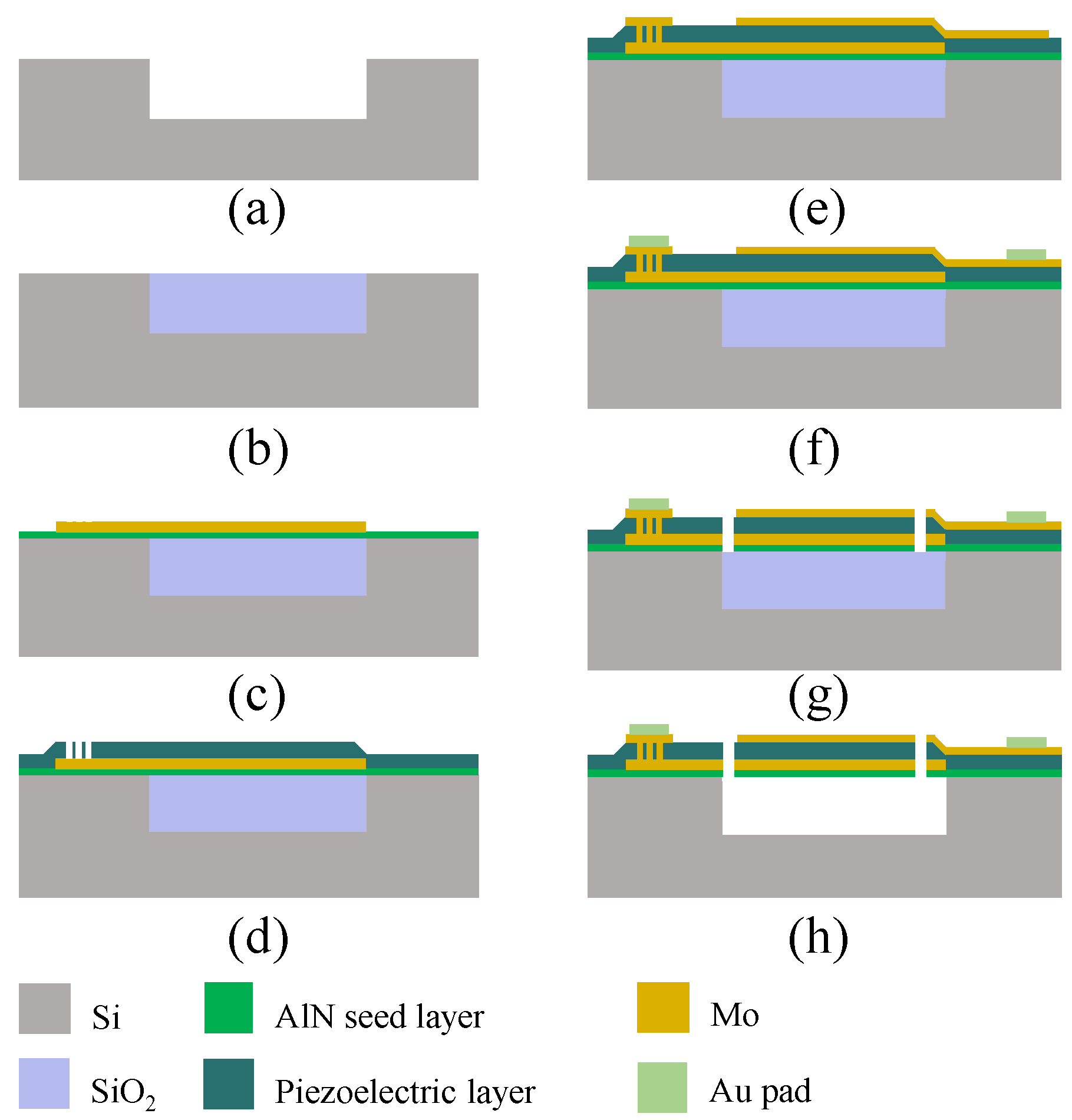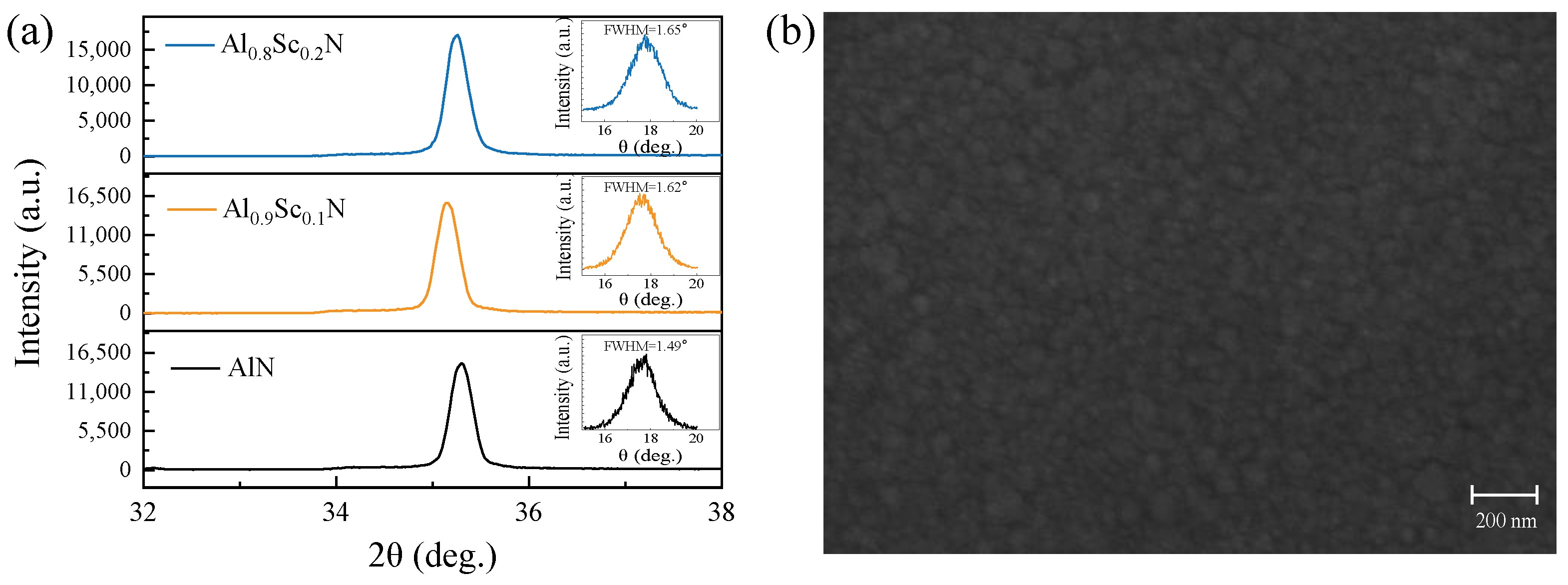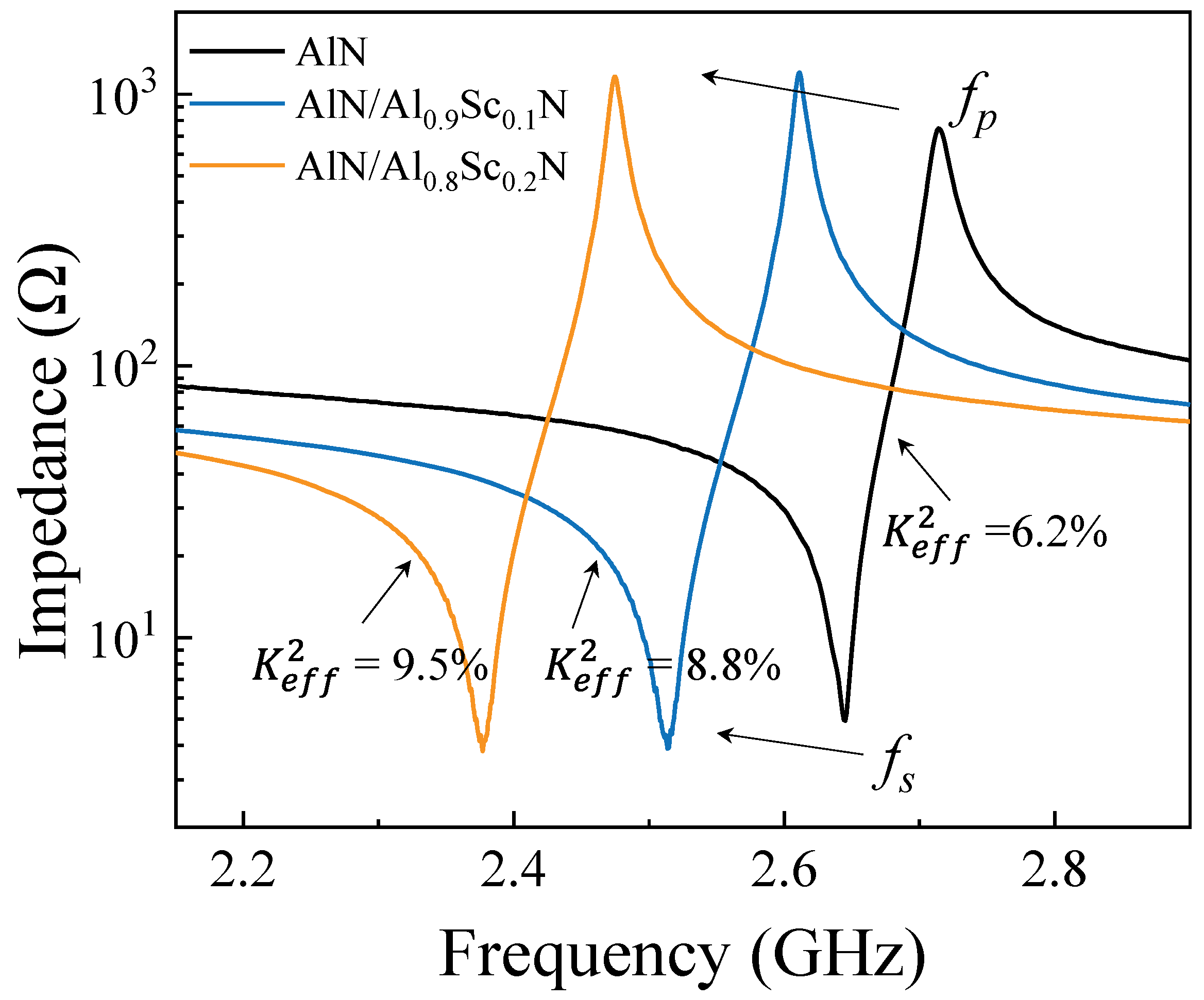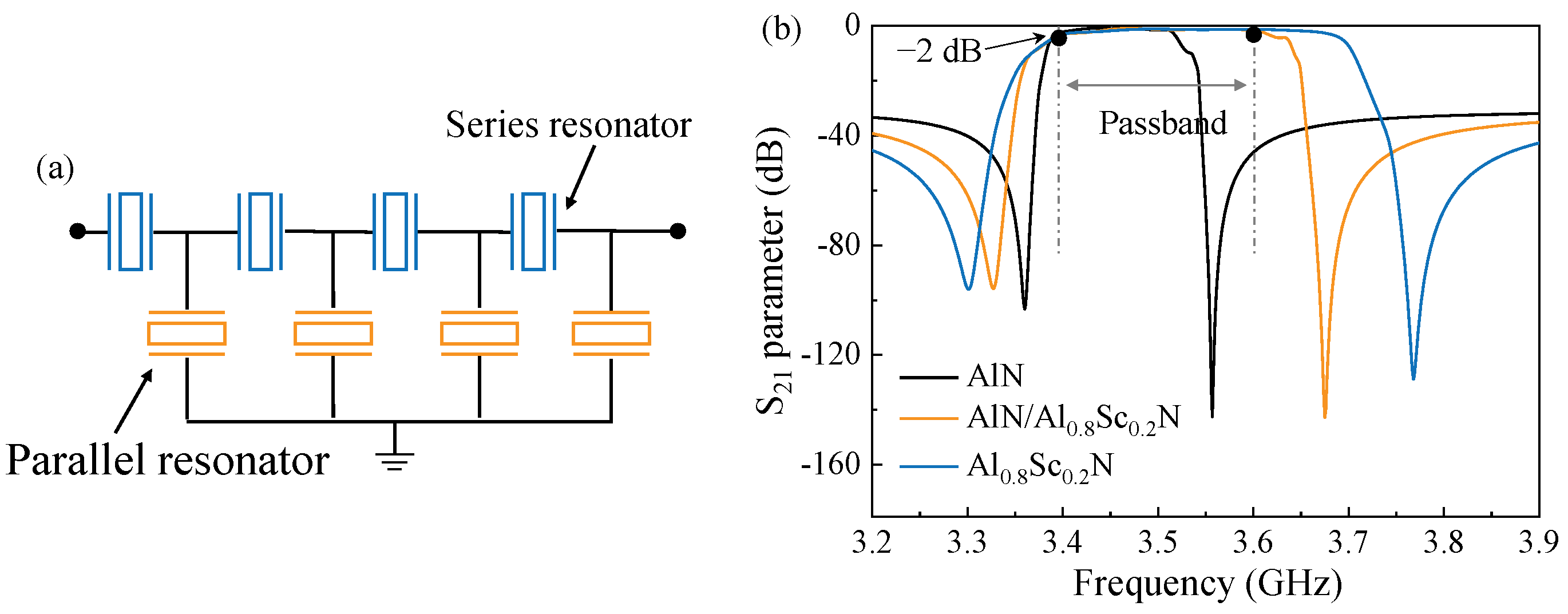Demonstration of Thin Film Bulk Acoustic Resonator Based on AlN/AlScN Composite Film with a Feasible
Abstract
:1. Introduction
2. Materials and Methods
3. Results and Discussions
4. Conclusions
Author Contributions
Funding
Data Availability Statement
Acknowledgments
Conflicts of Interest
References
- Yim, M.; Jeon, B.; Yoon, G. Feasibility Study of Small-sized FBAR-based Bandpass Filter Covering Digital Dividend Band for LTE Services. J. Semicond. Technol. Sci. 2020, 20, 479–484. [Google Scholar] [CrossRef]
- Wu, H.; Wu, Y.; Lai, Z.; Wang, W.; Yang, Q. A hybrid film-bulk-acoustic-resonator/coupled-line/transmission-line high selectivity wideband bandpass FBAR filter. IEEE Trans. Microw. Theory Tech. 2020, 68, 3389–3396. [Google Scholar] [CrossRef]
- Bhadauria, A.; Panchal, B.; Varghese, S. RF bandpass filters using FBAR with fractal electrodes. In Proceedings of the 2018 IEEE MTT-S International Microwave and RF Conference (IMaRC), Kolkata, India, 28–30 November 2018; pp. 1–3. [Google Scholar]
- Liu, Y.; Cai, Y.; Zhang, Y.; Tovstopyat, A.; Liu, S.; Sun, C. Materials, design, and characteristics of bulk acoustic wave resonator: A review. Micromachines 2020, 11, 630. [Google Scholar] [CrossRef] [PubMed]
- Yi, X.; Zhao, L.; Ouyang, P.; Liu, H.; Zhang, T.; Li, G. High-Quality Film Bulk Acoustic Resonators Fabricated on AlN Films Grown by a New Two-Step Method. IEEE Electron. Device Lett. 2022, 43, 942–945. [Google Scholar] [CrossRef]
- Wang, J.; Zheng, Y.; Ansari, A. Ferroelectric Aluminum Scandium Nitride Thin Film Bulk Acoustic Resonators with Polarization-Dependent Operating States. Physica Status Solidi (RRL)–Rapid Res. Lett. 2021, 15, 2100034. [Google Scholar] [CrossRef]
- Sorokin, B.P.; Asafiev, N.O.; Kvashnin, G.M.; Scherbakov, D.A.; Terentiev, S.A.; Blank, V.D. Toward 40 GHz excitation of diamond-based HBAR. Appl. Phys. Lett. 2021, 118, 083501. [Google Scholar] [CrossRef]
- Kvashnin, G.; Sorokin, B.; Asafiev, N.; Prokhorov, V.; Sotnikov, A. Peculiarities of the Acoustic Wave Propagation in Diamond-Based Multilayer Piezoelectric Structures as “Me1/(Al, Sc) N/Me2/(100) Diamond/Me3” and “Me1/AlN/Me2/(100) Diamond/Me3” under Metal Thin-Film Deposition. Electronics 2022, 11, 176. [Google Scholar] [CrossRef]
- Moreira, M.; Bjurström, J.; Katardjev, I.; Yantchev, V. Aluminum scandium nitride thin-film bulk acoustic resonators for wide band applications. Vacuum 2011, 86, 23–26. [Google Scholar] [CrossRef]
- Zhou, J.; Liu, Y.; Xu, Q.; Xie, Y.; Cai, Y.; Liu, J.; Liu, W.; Tovstopyat, A.; Sun, C. ScAlN/AlN Film-Based Lamé Mode Resonator With High Effective Electromechanical Coupling Coefficient. J. Microelectromech. Syst. 2021, 30, 677–679. [Google Scholar] [CrossRef]
- Li, L.; Gu, X.; Gao, C.; Hu, S.; Wang, Y.; Zou, Y.; Liu, Y.; Liu, W.; Cai, Y.; Sun, C. Micromechanics predictions of effective elastic, piezoelectric and dielectric properties of composite piezoelectric films. J. Microelectromech. Syst. 2022, 15, 095503. [Google Scholar] [CrossRef]
- Su, J.; Fichtner, S.; Ghori, M.Z.; Wolff, N.; Islam, M.; Lotnyk, A.; Kaden, D.; Niekiel, F.; Kienle, L.; Wagner, B. Growth of Highly c-Axis Oriented AlScN Films on Commercial Substrates. Micromachines 2022, 13, 783. [Google Scholar] [CrossRef]
- Wang, Y.; Zou, Y.; Gao, C.; Gu, X.; Ma, Y.; Liu, Y.; Liu, W.; Soon, J.B.W.; Cai, Y.; Sun, C. Effects of Electric Bias on Different Sc-Doped AlN-Based Film Bulk Acoustic Resonators. Electronics 2022, 11, 2167. [Google Scholar] [CrossRef]
- Chauhan, S.S.; Joglekar, M.M.; Manhas, S.K. Influence of process parameters and formation of highly c-Axis oriented AlN thin films on mo by reactive sputtering. J. Electron. Mater. 2018, 47, 7520–7530. [Google Scholar] [CrossRef]
- Gao, C.; Zou, Y.; Zhou, J.; Liu, Y.; Liu, W.; Cai, Y.; Sun, C. Influence of Etching Trench on K2 ef f of Film Bulk Acoustic Resonator. Micromachines 2022, 13, 102. [Google Scholar] [CrossRef] [PubMed]
- Ding, R.; Xuan, W.; Dong, S.; Zhang, B.; Gao, F.; Liu, G.; Zhang, Z.; Jin, H.; Luo, J. The 3.4 GHz BAW RF Filter Based on Single Crystal AlN Resonator for 5G Application. Nanomaterials 2022, 12, 3082. [Google Scholar] [CrossRef]
- Nam, K.; Park, Y.; Ha, B.; Shim, D.; Song, I.; Pak, J.; Par, G.J. Piezoelectric properties of aluminum nitride for thin film bulk acoustic wave resonator. J. Korean Phys. Soc. 2005, 47, 309. [Google Scholar]
- Ambacher, O.; Christian, B.; Feil, N.; Urban, D.; Elsässer, C.; Prescher, M.; Kirste, L.J. Wurtzite ScAlN, InAlN, and GaAlN crystals, a comparison of structural, elastic, dielectric, and piezoelectric properties. J. Appl. Phys. 2021, 130, 045102. [Google Scholar] [CrossRef]
- Zhang, S.; Fu, W.Y.; Holec, D.; Humphreys, C.; Moram, M. Elastic constants and critical thicknesses of ScGaN and ScAlN. J. Appl. Phys. 2013, 114, 243516. [Google Scholar] [CrossRef]
- Caro, M.A.; Zhang, S.; Riekkinen, T.; Ylilammi, M.; Moram, M.A.; Lopez-Acevedo, O.; Molarius, J.; Laurila, T. Piezoelectric coefficients and spontaneous polarization of ScAlN. J. Phys. Condens. Matter 2015, 27, 245901. [Google Scholar] [CrossRef] [PubMed] [Green Version]
- Wingqvist, G.; Tasnadi, F.; Zukauskaite, A.; Birch, J.; Arwin, H.; Hultman, L. Increased electromechanical coupling in w − ScxAl1−xN. Appl. Phys. Lett. 2010, 97, 112902. [Google Scholar] [CrossRef]
- Wang, W.; Mayrhofer, P.M.; He, X.; Gillinger, M.; Ye, Z.; Wang, X.; Bittner, A.; Schmid, U.; Luo, J. High performance AlScN thin film based surface acoustic wave devices with large electromechanical coupling coefficient. Appl. Phys. Lett. 2014, 105, 133502. [Google Scholar] [CrossRef]
- Kurz, N.; Ding, A.; Urban, D.F.; Lu, Y.; Kirste, L.; Feil, N.M.; Žukauskaitė, A.; Ambacher, O. Experimental determination of the electro-acoustic properties of thin film AlScN using surface acoustic wave resonators. J. Appl. Phys. 2019, 126, 075106. [Google Scholar] [CrossRef]
- Wang, J.; Park, M.; Mertin, S.; Pensala, T.; Ayazi, F.; Ansari, A. A film bulk acoustic resonator based on ferroelectric aluminum scandium nitride films. J. Microelectromech. Syst. 2020, 29, 741–747. [Google Scholar] [CrossRef]
- Yokoyama, T.; Iwazaki, Y.; Onda, Y.; Nishihara, T.; Sasajima, Y.; Ueda, M. Highly piezoelectric co-doped AlN thin films for wideband FBAR applications. IEEE Trans.Ultrason.Ferroelectr. Freq. Control. 2015, 62, 1007–1015. [Google Scholar] [CrossRef] [PubMed]
- Tang, J.; Niu, D.; Yang, Y.; Zhou, D.; Yang, C. Preparation of ScAlN films as a function of sputtering atmosphere. J. Mater. Sci. Mater. Electron. 2016, 27, 4788–4793. [Google Scholar] [CrossRef]
- Dargis, R.; Clark, A.; Ansari, A.; Hao, Z.; Park, M.; Kim, D.; Yanka, R.; Hammond, R.; Debnath, M.; Pelzel, R. Single-Crystal Multilayer Nitride, Metal, and Oxide Structures on Engineered Silicon for New-Generation Radio Frequency Filter Applications. Phys. Phys. Phys. Status Solidi A 2020, 217, 1900813. [Google Scholar] [CrossRef]
- Fichtner, S.; Reimer, T.; Chemnitz, S.; Lofink, F.; Wagner, B. Stress controlled pulsed direct current co-sputtered Al1−xScxN as piezoelectric phase for micromechanical sensor applications. APL Mater. 2015, 3, 116102. [Google Scholar] [CrossRef] [Green Version]
- Sandu, C.S.; Parsapour, F.; Mertin, S.; Pashchenko, V.; Matloub, R.; LaGrange, T.; Heinz, B.; Muralt, P. Abnormal grain growth in AlScN thin films induced by complexion formation at crystallite interfaces. Phys. Status Solidi A 2019, 216, 1800569. [Google Scholar] [CrossRef]







| AlN | Al0.9Sc0.1N | Al0.8Sc0.2N | |
|---|---|---|---|
| ρ (kg/m2) | 3260 | 3460 | 3560 |
| εr | 9.5 | 10.8 | 13.4 |
| e31 (C/m2) | −0.58 | −0.62 | −0.71 |
| e33 (C/m2) | 1.55 | 1.67 | 2.08 |
| e24 (C/m2) | −0.48 | −0.30 | −0.27 |
| C11 (GPa) | 345 | 320 | 292 |
| C12 (GPa) | 125 | 127 | 130 |
| C13 (GPa) | 120 | 126 | 134 |
| C33 (GPa) | 395 | 324 | 258 |
| C44 (GPa) | 118 | 108 | 104 |
| C66 (GPa) | 110 | 110 | 91 |
| Dimension | Filter 1 | Filter 2 | Filter 3 |
|---|---|---|---|
| Thickness of bottom Mo(nm) | 184 | 103 | 102 |
| Thickness of AlN (nm) | 686 | - | 316 |
| Thickness of Al0.8Sc0.2N (nm) | - | 679 | 473 |
| Thickness of top Mo (nm) | 164 | 103 | 100 |
| Thickness of Mass loading Mo (nm) | 21 | 41 | 30 |
Publisher’s Note: MDPI stays neutral with regard to jurisdictional claims in published maps and institutional affiliations. |
© 2022 by the authors. Licensee MDPI, Basel, Switzerland. This article is an open access article distributed under the terms and conditions of the Creative Commons Attribution (CC BY) license (https://creativecommons.org/licenses/by/4.0/).
Share and Cite
Nian, L.; Zou, Y.; Gao, C.; Zhou, Y.; Fan, Y.; Wang, J.; Liu, W.; Liu, Y.; Soon, J.B.; Cai, Y.;
et al. Demonstration of Thin Film Bulk Acoustic Resonator Based on AlN/AlScN Composite Film with a Feasible
Nian L, Zou Y, Gao C, Zhou Y, Fan Y, Wang J, Liu W, Liu Y, Soon JB, Cai Y,
et al. Demonstration of Thin Film Bulk Acoustic Resonator Based on AlN/AlScN Composite Film with a Feasible
Nian, Laixia, Yang Zou, Chao Gao, Yu Zhou, Yuchen Fan, Jian Wang, Wenjuan Liu, Yan Liu, Jeffrey Bowoon Soon, Yao Cai,
and et al. 2022. "Demonstration of Thin Film Bulk Acoustic Resonator Based on AlN/AlScN Composite Film with a Feasible
Nian, L., Zou, Y., Gao, C., Zhou, Y., Fan, Y., Wang, J., Liu, W., Liu, Y., Soon, J. B., Cai, Y., & Sun, C.
(2022). Demonstration of Thin Film Bulk Acoustic Resonator Based on AlN/AlScN Composite Film with a Feasible







